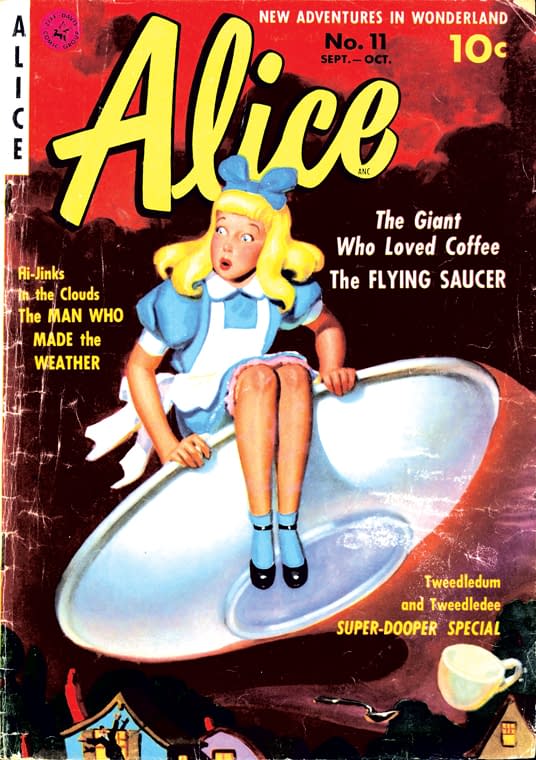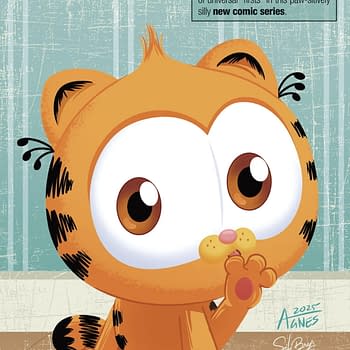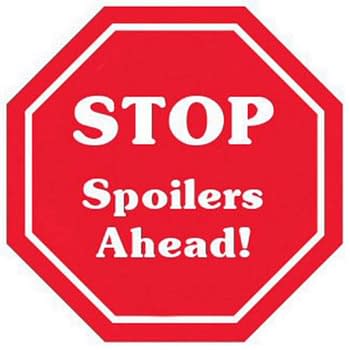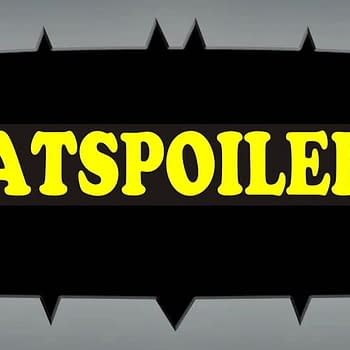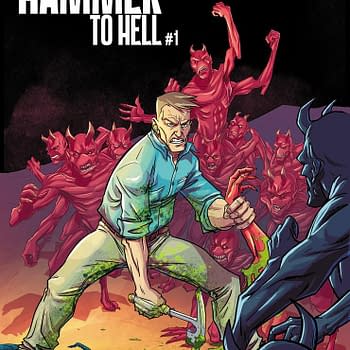Posted in: Comics, Recent Updates | Tagged: Alice in Comicland, alice in wonderland, Charles Schultz, Comics, Comics About Cartoonists: Stories about the World's Oddest Profession, Craig Yoe, entertainment, idw, jack kirby, Jules Feiffer, lewis carroll, Matt Groenig, mike mignola, steve ditko, wally wood, will eisner, Yoe Books!
Alice in Comicland Gets Curiouser and Curiouser – Craig Yoe In the Bleeding Cool Interview
Craig Yoe is the Indiana Jones of comics history and archival work, and it turns out that just like Indy, he's been doing this ever since he was a young teen. Also, like Indy, everything he discovers is meant to be delivered into the hands of the public where it can be justly appreciated and even, perhaps, of influence. Though he's edited and curated many books of classic comics and strips, in 2010, he embarked editing the Yoe! Books imprint of fine collections from IDW and in 2012 produced Comics About Cartoonists: Stories About the World's Oddest Profession featuring the works of so many legendary artists that it puts a general lack of knowledge about the existence of such cartoons to shame. But his new project, Alice in Comicland is the culmination of a lifelong curiosity and pursuit of the impact of Lewis Caroll's Alice in Wonderland on the comics medium.
Like Comics About Cartoonists, Alice in Comicland is a beautifully bound, large book stuffed with content and renders in vivid, clear reproduction the works of many great masters. You'll never realize how many comics creators were obsessed with Alice stories until you peruse this anthology, but Craig Yoe did and was determined to give readers access to these tales. The contents of this book are both breathtaking at times, and in equal parts wacky, and occasionally disturbing. The wild possibilities of the original book are clearly firing creative imaginations in almost limitless directions. Humor comics, adventure comics, horror comics, and even hero comics have all been entranced by Alice.
Craig Yoe talks with us here at Bleeding Cool about the Yoe! Books imprint, the expansive list of creators who produced Alice comics (you'll be surprised), and why Alice stories mean just about "everything" to him as a preserver of comics.
HMS: Tell me a little bit about Yoe! Books at IDW and the history of that imprint. Why have you chosen the anthologies you've chosen to work on so far, and why Alice in Comicland?
Craig Yoe: Hannah, Yoe Books was started going on 5 years ago when Greg Goldstein suggested to that comics publishing visionary Ted Adams that IDW start an imprint headed by me focusing on great vintage comics. Greg and I were "business" friends in the licensing industry, working on some projects together, seeing each other at licensing conventions and parties, etc. But we didn't know that each other had such a raging passion for comics. At the time Greg was luckily snatched by IDW he saw my book Secret Identity: The Fetish Art of Superman's Co-Creator Joe Shuster and realized that I, too, was a hopeless comic book fanatic like himself.
So, as one of his first acts at his new gig, Greg dreamed up our publishing relationship and we've now done something like 50 books: lots of horror comics collections, cool kid stuff, a grand book about the brilliant humorous cartoonist Milt Gross, books featuring awesome characters like Felix, Krazy Kat, Barney Bear and Popeye, some glorious Ditko volumes and my favorite book I'll ever do: Comics About Cartoonists: The World's Oddest Profession.
When I say "we," along with me it's the stupendous folks at IDW including our main editor Justin Eisinger and my full partner in this, the intelligent and talented Clizia Gussoni, who produces the books. She and I have produced lots of books and children together—we're into reproduction!
It astonishes me that we've published in our books for IDW and others work by so many stellar artists: Jack Kirby, Carl Barks, Dick Briefer, George Herriman, E.C. Segar, Bud Sagendorf, Frank Frazetta, Dean Yeagle, Jack Cole, Mort Walker, Bob Powell, Rube Goldberg, Thomas Nast, Chester Gould, Boody Rogers and Will Eisner. There have also been Ernie Bushmiller, Matt Groening, Jules Feiffer, Al Capp, Mike Mignola, John Stanley, Bruce Timm, Steve Ditko, Wally Wood and many more luminaries!
In the Alice book alone we have Charles Schulz, Harvey Kurtzman, Walt Kelly, R.F. Outcault, Dan DeCarlo, George Carlson, Dave Berg and Jack Davis, plus many other greats!
My books have had introductions by John Updike, Paul Krassner, R. Crumb, Stan Lee, Nobel Peace Price-winner Muhammad Yunus and Jerry Only of the Misfits!
All this has been for me grateful Craig Yoe in Wonderland!
We choose the books to work on based on what I love… known and unknown cartoonists that deserve more or some recognition, comics that have tres cool artwork, comics that I like to read to my kids, work that will startle people, comics where F-U-N is the operative word, book subjects that I could have a good time designing a book around. Sometimes we even choose projects based on what might sell pretty well. And occasionally some of the books will have a bunch of those elements in them.
Alice in Comicland might fit most of that criteria. Lessee… I love Alice, Walt Kelly deserves more recognition, no one has ever even heard of horror comics master Stephen Kirkel, these are terrific comics to read to my young'uns, I think some minds will be blown by some of the what-the-fork stories, the book is totally fun, designing the cover where the sophisticated black-and-white John Tenniel-drawn Alice is about to go through the die-cut hole of the cover into the lurid world of comics was a blast, and because Alice is Alice we're already enjoying boffo sales! Alice is the perfect Yoe Book!
HMS: I had no idea, honestly, that Alice had appeared in so many diverse guises in comics. To you, what's the strangest incarnation you've found, and what discovery has added to your appreciation of the original book the most?
CY: I just gave a talk on "Alice in Comicland" at the Spring meeting of the Lewis Carroll Society of North America. That was the SECOND time I talked on the subject of Alice and comics. The first was nearly 50 years ago! When I was 14 years old in 1965, a professor at Ohio State heard I was collecting Alice in comics ephemera and invited me to be a guest lecturer.
Half a century later I'm STILL discovering new goodies, yes, even after the book has been published, though I'm quick to point out nothing I felt that I've since uncovered really needed to be in the book. But even at the Carroll conference some of the Alice devotees were telling me about some rarities new to me. As far as "strangest," I guess that would be the Alice horror comic stories by Alex Toth and Stephen Kirkel. Alice in a horror story is pretty bizarre and these two particular ones which we include in the book are truly horrifying. I love 1950's horror comics but most, of them, from our perspective now, are less than frightening and more about being fun. But these two horror comics tales featuring our heroine Alice are really spine-chilling!
On the other hand, the strangest could be the Alice from the turn-of-the century pioneering comic strip in the Chicago Tribune where Alice looks not-unlike Alfred E. Neuman! In comics Alice had a couple of sex changes, was demonized, Disney-fied and was even the What-Me-Worry kid—bizarro! What were these cartooning caterpillars smoking?! And let's not forget what is many people's favorite part of the book, when Snoopy becomes the Cheshire Cat–the sequences are reproduced from Charles Schulz's original art courtesy of the Schulz Museum! We have a Archie in Alice Drag reproduced from the original art by Dan DeCarlo and even unpublished pages by Mr. Walt "Pogo" Kelly! This Kelly original art is from the collection of the esteemed President of The Lewis Carroll Society of North America, Mark Burstein, who wrote the most excellent intro to Alice in Comicland that fascinatingly puts the comics into historical context.
All of Alice's varied incarnations make me appreciate what a fascinating character and world it was that Lewis Carroll and John Tenniel created and how fun it is to play in that realm with its many depths and infinite possibilities!
HMS: How do you make sure that these older comics are presented in their full glory for readers? What kind of research, archival work, and technology are necessary, Craig?
CY: Every restorer has their own approach to preparing old comics for contemporary book reproduction. We take a "light approach". We think the tanned paper and some of the off-register printing add to the aesthetic of what great vintage comics are. Some people might see warts–we see beauty marks. But while I believe our approach gives the readers an authentic and enjoyable experience at the same time I quickly add that we actually spend much time on every page that goes into one of our books.
We try and make sure the original printing hasn't obscured the legibility of the art or lettering. We labor intensely to adjust colors to bring them to point that they are as bright as when the first appeared on a newsstand, making the black lines crisp and clear as possible, fixing original typos, etc. We spend hours, sometimes DAYS on each page making them look good while preserving the original feel of the art and creating a reading experience as if you were curled up with the comic in the 1940's or 50's.
Clizia's mom is now a full-time part of our team and she spent her lifetime career in Rome working in the government department there that is in charge of the care and preservation of the ancient Roman artifacts! She brings the same kind of attention to the restoring of the comics as one would bring to preserving a priceless early Roman vase!
HMS: Are you thinking as you're working on a book like this, "We're doing this for libraries, for future generations" as well as for readers who might appreciate it and make new discoveries right now?
CY: The libraries and future generations are definitely in mind, and certainly, too, our valued readers, but I also often think of today's creators when putting together our books. I get frustrated by the lack of craftsmanship in the art and writing and storytelling that I see in many–not all–contemporary comics. And I strongly think many of today's comics just aren't plain FUN like the comics of the past. So I often dream about current creators diving in and learning some chops and being inspired by the wondrous classic comics by known and unknown geniuses!
HMS: What are the greatest enemies to originality in comics right now? How can rediscovering past comic traditions have a positive influence on creators and readers?
CY: It's a certain kind of irony, I suppose, but the greatest enemy to today's comics' originality is that they DON'T steal from the past. Today's cartoonists don't plunder the glorious 1940's and 50's comic books and the comic strips that preceded them. Those were the periods of innovation, things hadn't been reduced to formula, they were produced co-current with the Golden Age of Illustration and the best cartoonists were neck-and-neck with their contemporaries in the slick magazine and illustrated book field.
Hannah, we need to capture some of that luster of the past, the creative bombasts that were comics. Too few current comics' creators learn and embrace those past glories. If they did present comics and future comics would be much better–and a whole lot more fun!
HMS: What do the story and characters from "Alice in Wonderland" mean to you personally? Have they had an impact on your mind and life?
CY: Hannah, I first read the "Alice" books in the same period I had rediscovered comic books as a young teen—those incredibly impressionable years. So Alice meant to me as much as Little Lulu. The Mad Hatter as much as Batman. The hookah-smoking caterpillar as much as the Fabulous Furry Freak Brothers. Humpty Dumpty as much at Herbie Popnecker. The Cheshire Cat as much as Krazy Kat. The Queen of Hearts as much as Dr. Doom. These characters meant to me… EVERYTHING!

Hannah Means-Shannon is EIC at Bleeding Cool and @hannahmenzies on Twitter



